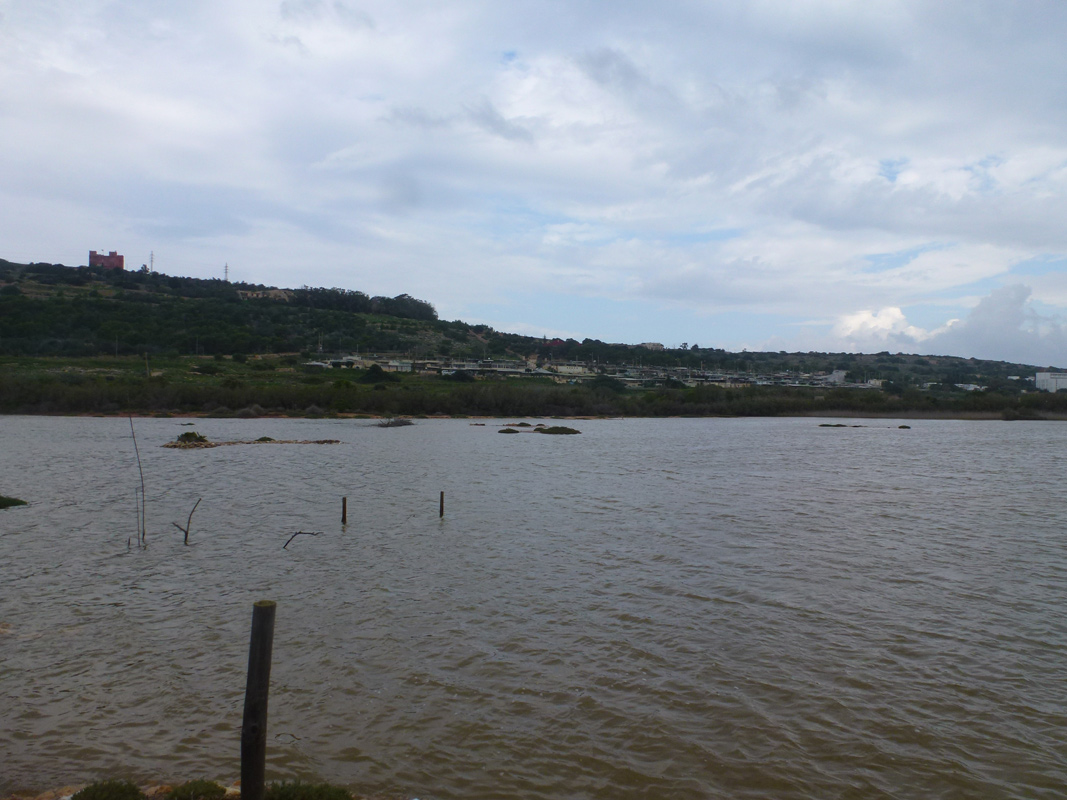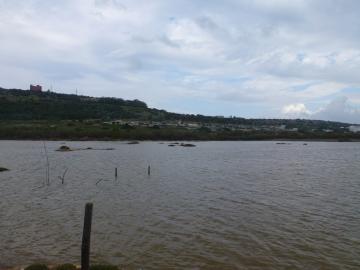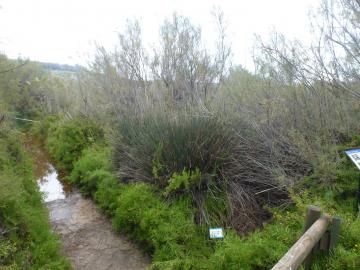MAL001 - L-Ghadira
Description
The Għadira Wetland falls within a Special Area of Conservation (SAC) and Special Protection Area (SPA) found within the Mellieħa locality boundary. To the north of the site is the Marfa Ridge whilst to the south is the Mellieħa Ridge. The site is one of the richest in biodiversity, particularly for avifauna. It supports one of the most successful bird sanctuaries in the country, acting as a nesting and breeding site for several protected species. The latter aspect attracts many visitors to the area, making the Għadira reserve the most popular Wetland Reserve in Malta, with around 8,000 visitors a year, many of whom include school children. In view of this, this SAC is an important site for ecotourism and environmental education. The Ghadira Wetland is one of two Ramsar sites in the Maltese Islands.This inland surface water body is protected as a lake under the Water Framework Directive (200/06/EC, LN 198/04). Studies undertaken between 1985 and 1986 showed that salinity in the reserve’s wetland varied from 7 to 40%. The salinity fluctuations are related to precipitation and sea water seepage. In summer the precipitation is at its lowest and the sea water seeps in the wetland. Increased evaporation contributes to increase the levels of salinity. The Coastal Lagoon (habitat 1150*) at l- Għadira is considered to be probably the best example of this habitat in the Maltese Islands. The lagoon supports a thriving population of the endemic Annex II species, the Maltese Killifish and a considerable number of Annex I bird and migratory bird species. The lagoon also presents suitable foraging habitat for bats. Over 100 species of invertebrates are known from the reserve as well as the only species of amphibian in the Maltese Islands, the Painted Frog.The main reason behind the creation of the Għadira wetland was to provide a variety of bird species with ideal breeding grounds, as well as an important feeding and resting area for migratory birds. The Black winged Stilt is establishing a breeding population within the Għadira lagoon. Other breeding birds at the reserve include the Little Ringed Plover and the Moorhen, and the passerines the Zitting Cisticola, the Sardinian Warbler and Cetti’s Warbler.The Short-toed Lark has a breeding population of 3-5 pairs at the garrigue patch situated in the western end of the site. The reserve is an important stopover in both spring and autumn migration periods. Over 100 migratory bird species have been recorded at L-Għadira Wetland Reserve and flocks of herons and egrets can exceed fifty birds at any one time. Passerines also winter within the reserve.The dune habitat is heavily disturbed as a result of the road that intersects the dune system, disconnecting it from the beach. Reclamation for agriculture and habitat modification prior to the Wetland Reserve creation obliterated the largest part of the remaining inland dunes. Nowadays, a remnant habitat, of an area of 11,300 m2 patch is present within the outer grove of the Għadira Wetland Reserve. This habitat patch is still densely vegetated with alien species, including invasive Acacia and ruderals. Two Annex II invertebrate species are known from this area, a cricket and a beetle.Foresta 2000, an afforestation project that has been carried out on part of the ridge above the wetland has created safe roosting habitat and attracts raptor species. Migrant passerines rest and forage at the garrigue and arboreal habitats.Several activities exert pressure on the ecology of the site. The Għadira area is popular with tourists and experiences pressures from recreational activities as well as pressure from development including impacts from noise, trampling, habitat disturbance and habitat loss.Overuse of fertilizers and pesticides from surrounding agricultural practices exerts pressure on the wetland from eutrophication and water pollution. Hunting is prohibited in the entire SAC/SPA site since the area falls within a Bird Sanctuary, however, poaching is practiced in the areas bordering the SAC/SPA. Poachers’ intrusions and poaching within the Bird Sanctuary, resulting in losses of rare Annex I bird species, is not uncommon. Other activities that involve the removal or collection of animals also impacts wildlife at this site.Trapping might be still present in private land and illegally practiced also in public land. As a practice it is responsible for vegetation clearings and habitat modification, disturbance of wildlife and direct biodiversity loss. Localised dumping is evidenced amongst the Annex I habitats that are close to the access road.

Wetland data
Basic information
| Wetland location: | Marine/Coastal |
| Wetland type: | Natural |
| Wetland area: | 8.10 Ha |
| Hydrological interaction: | - |
| Water salinity: | Brackish (5.0-18.0 g/l) |
| Type of fresh water input: | Catchment area (precipitation) |
| Surface water runoff | Outflow controlled by pipeline |
| Open water area (%): | 76 - 95 |
| Hydroperiod: | Permanent |
Geographic information
| Census district: | Northern |
| Island: | Malta |
| Local council: | Il-Mellieha |
| Longitude: | 14.347440 East |
| Latitude: | 35.970130 North |
Ramsar wetland type
| Type | Coverage (%) |
| J -- Coastal brackish/saline lagoons; brackish to saline lagoons with at least one relatively narrow connection to the sea |
Property status
| Public |
| Protection status category | Protection status subcategory | Area's name | Code | Coverage area (%) | Legislation |
| National | Area of Ecological Importance/Site of Scientific Importance | L-Inhawi ta' l-Ghadira mill-Bajja tal-Mellieha sac-Cumnija fil-Mellieha | 330747 | 100 | Development Planning Act (Act VII of 2016) |
| National | Bird Sanctuary | Il-madwar ta' l-Ghadira, fil-Bajja tal-Mellieha | 11704 | 100 | Environment Protection Act (Act I of 2016) |
| International | Special Areas of Conservation - International Importance | L-Inhawi ta' l-Ghadira | 330721 | 100 | Environment Protection Act (Act I of 2016) |
| International | Special Protection Areas | L-Inhawi ta' l-Ghadira | 555552404 | 100 | Environment Protection Act (Act I of 2016) |
| International | Ramsar Sites | L-Ghadira | 100 | ||
| International | Transitional waters | L-Ghadira | MT TW 05 | 100 | Water Framework Directive |
CDDA protection status
| CDDA code | CDDA category |
| MT02 | Area of Ecological Importance/Site of Scientific Importance |
| MT03 | Bird Sanctuary |
| MT11 | Special Areas of Conservation - International Importance |
| MT13 | Special Protection Areas |
Ecosystem services
| Type of ecosystem service | Ecosystem service | Scale of Βenefit (%) | Importance |
| Cultural services | Cultural heritage | ||
| Supporting services | Provision of habitat | ||
| Cultural services | Recreation and tourism |
Activities on wetland
| Activity | Intensity |
| 010 = Habitat conservation | High |
| 030 = Species conservation | High |
| 160 = General forestry management | High |
| 162 = artificial planting | High |
| 610 = Interpretative centres | High |
| 701 = water pollution | High |
| 830 = Canalisation | High |
| 853 = management of water levels | High |
| 952 = eutrophication | Low |
Activities on catchment area
| Activity | Intensity |
| 010 = Habitat conservation | High |
| 030 = Species conservation | High |
| 100 = Cultivation | High |
| 110 = Use of pesticides | High |
| 120 = Fertilisation | High |
| 130 = Irrigation | High |
| 160 = General forestry management | High |
| 402 = discontinuous urbanisation | Medium |
| 430 = Agricultural structures | Medium |
| 502 = roads motorways | High |
| 625 = gliding delta plane paragliding ballooning | High |
| 701 = water pollution | High |
Impacts
| Impact | Intensity |
| EB- = Increase in aesthetic qualities | High |
| EP- = Reduction of salt intrusion potential | High |
| ER- = Increase in flow regulation | High |
| EU- = Increase of tourist/recreation potential | High |
| EW- = Increase in wilderness/wildlife values | High |
| PC- = Chemical pollution | High |
| PF- = Fertilizer/Excess nutrient pollution | High |
| PP- = Pesticide pollution | High |
Habitat types
| Type | Coverage (%) |
| 1150 * Coastal lagoons | 26 - 50 |
| 1310 Salicornia and other annuals colonizing mud and sand | 5 - 25 |
| 1410 Mediterranean salt meadows (Juncetalia maritimi) | 5 - 25 |
| 1420 Mediterranean and thermo-Atlantic halophilous scrubs (Sarcocornetea fruticosi) | 5 - 25 |
| 2220 Dunes with Euphorbia terracina | < 5 |
Vegetation types
| Type | Coverage (%) |
| Shrubby / Arborescent | 5 - 25 |
| Halophytic | 5 - 25 |
| Wet meadow | |
| Other | |
| Ammophilous | |
| Emergent | < 5 |
Flora
| Species | Presence status | References |
| Acacia saligna | ||
| Jacobaea crithmoides | ||
| Juncus acutus | ||
| Juncus subulatus | ||
| Orobanche densiflora | ||
| Oxalis pes-caprae | ||
| Pancratium maritimum | ||
| Phragmites australis | ||
| Pinus halepensis | ||
| Pistacia lentiscus | ||
| Punica granatum | ||
| Rhamnus alaternus | ||
| Salicornia ramosissima | ||
| Tamarix africana | ||
| Tetraclinis articulata |
Fauna
| Mammals | Presence status in wetland | References | |
| Mustela nivalis (L., 1766) | |||
| Myotis punicus (Felten, 1977) | |||
| Nyctalus noctula (Schreber, 1774) | |||
| Oryctolagus cuniculus (Linnaeus, 1758) | |||
| Pipistrellus kuhlii (Kuhl, 1817) | |||
| Pipistrellus pipistrellus (Schreber, 1774) | |||
| Plecotus austriacus (Fischer, 1829) | |||
| Rhinolophus hipposideros (Bechstein, 1800) | |||
| Suncus etruscus (Savi, 1822) | |||
Birds |
Number of individuals |
Nesting |
References |
| Circus aeruginosus (Linnaeus, 1758) | |||
| Circus cyaneus (Linnaeus, 1766) | |||
| Circus macrourus | |||
| Circus pygargus (Linnaeus, 1758) | |||
| Anas crecca (Linnaeus, 1758) | |||
| Aythya ferina (Linnaeus, 1758) | |||
| Actitis hypoleucos (Linnaeus, 1758) | |||
| Calidris alpina (Linnaeus, 1758) | |||
| Calidris ferruginea (Pontoppidan, 1763) | |||
| Calidris minuta (Leisler, 1812) | |||
| Charadrius dubius (Scopoli, 1786) | |||
| Gallinago gallinago (Linnaeus, 1758) | |||
| Himantopus himantopus (Linnaeus, 1758) | |||
| Scolopax rusticola (Linnaeus, 1758) | |||
| Ardeola ralloides (Scopoli, 1769) | |||
| Ixobrychus minutus (Linnaeus, 1766) | |||
| Alcedo atthis (Linnaeus, 1758) | |||
| Gallinula chloropus (Linnaeus, 1758) | |||
| Rallus aquaticus (Linnaeus, 1758) | |||
| Acrocephalus schoenobaenus (Linnaeus, 1758) | |||
| Anthus spinoletta (L, 1758) | |||
| Calandrella brachydactyla (Leisler, 1814) | |||
| Cettia cetti (Temminck, 1820) | |||
| Cisticola juncidis (Rafinesque, 1810) | |||
| Emberiza pusilla | |||
| Emberiza schoeniclus (Linnaeus, 1758) | |||
| Erithacus rubecula (Linnaeus, 1758) | |||
| Ficedula semitorquata (Homeyer, 1885) | |||
| Phylloscopus collybita (Vieillot, 1817) | |||
| Phylloscopus sibilatrix (Bechstein, 1793) | |||
| Phylloscopus trochilus (Linnaeus, 1758) | |||
| Saxicola rubetra (Linnaeus, 1758) | |||
| Sylvia communis (Latham, 1787) | |||
| Sylvia melanocephala (J.F. Gmelin, 1789) | |||
| Jynx torquilla (Linnaeus, 1758) | |||
| Tachybaptus ruficollis (Pallas, 1764) | |||
Reptiles |
Presence status in wetland |
References |
|
| Chalcides ocellatus tiligugu (Gmelin, 1789) | |||
| Chamaeleo chamaeleon (Linnaeus, 1758) | |||
| Coluber viridiflavus carbonarius (Bonaparte, 1833) | |||
| Hemidactylus turcicus (Arnold, 1980) | |||
| Podarcis filfolensis maltensis (Mertens, 1921) | |||
| Tarentola mauritanica (Linnaeaus, 1758) | |||
| Telescopus fallax (Fleischmann, 1831) | |||
| Zamenis situla (Linnaeus, 1758) | |||
Amphibians |
Presence status in wetland |
References |
|
| Discoglossus pictus (Otth, 1837) | |||
Fishes |
Presence status in wetland |
References |
|
| Aphanius fasciatus (Valenciennes, 1821) | |||
Invertebrates |
Presence status in wetland |
References |
|
| Tetragnatha extensa (Linnaeus, 1758) | |||
| Anthicus fenestratus (W.L.E. Schmidt, 1842) | |||
| Cyclodinus humilis (Germar, 1824) | |||
| Cyclodinus minutus (La Ferté-Sénectère, 1842) | |||
| Leptaleus rodriguesi (Latreille, 1804) | |||
| Anoxia australis (Gyllenhal, 1817) | |||
| Scarabeus semipunctatus (Fabricius, 1792) | |||
| Allophylax picipes melitensis (Baudi de Selve, 1876) | |||
| Ammobius rufus (Lucas, 1849) | |||
| Erodius siculus melitensis (Reitter, 1914) | |||
| Pseudoseriscius cameroni (Reitter, 1902) | |||
| Stenosis melitana (Reitter, 1894) | |||
| Stenosis schembrii (Canzoneri, 1979) | |||
| Protrama baronii | |||
| Philanthus raptor siculus (Giordani Soika, 1944) | |||
| Smicromyrme n.sp.(?) | |||
| Tachyagetyes n.sp. (?) | |||
| Prionyx viduatus (Christ, 1791) | |||
| Coleophora mellechella (Toll, 1962) | |||
| Trithemis annulata (Palisot de Beauvois, 1807) | |||
| Brachytrupes megacephalus (Lefèvre, 1827) | |||
| Odontura stenoxipha (Fieber, 1853) | |||
| Gammarus aequicauda (Martynov, 1931) |
Adi Associates Environmental Consultants Ltd (2004) Mellieħa Bay: Regional Environmental Assessment.
Adi Epsilon Consortium (2014f) L-Inhawi tal-Ghadira – Natura 2000 Management Plan (SAC). Prepared for the Malta Environment and Planning Authority under CT3101/2011. San Gwann, Malta, pp. 112 + Annex
Birdlife (n/a) Għadira Nature Reserve Management Plan 2010-2014
Deidun, A., Diacono, I., Tigano, C. & Schembri, P.,(2002) Present distribution of the threatened killifish Aphanius fasciatus (Actinopterygii, Cyprinodontidae) in the Maltese Islands. Central Mediterranean Naturalist, 3(4), pp. 177-180.
ERA (2015) The 2 nd Water Catchment Management Plan for the Malta Water Catchment District 2015 - 2021
Kenneth Pye Associates Ltd (2009) Coastal Geomorphological Changes at Għadira Beach (Mellieħa Bay) Malta: Scoping Study Report
Zammit-Mangion, M. & Deidun, A., (2010) Management Recommendations For The Conservation Of Threatened Aphanius Fasciatus NardoPopulations From Two Wetlands In The Maltese Islands. s.l., s.n., pp. 356-357.
Zammit-Mangion, M. (2009) Action Plan for Aphanius fasciatus at the Għadira Nature Reserve and the Simar Bird Sanctuary.



